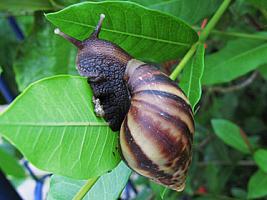The Giant African Land Snail (Achatina fulica) is considered a pest in various countries around the world. It was illegally introduced in many countries to offer a more economically viable and heavier alternative to the true escargot (Helix aspersa). However, it was soon discovered that the snail was not well accepted by the consumer market, leading to the abandonment of breeding efforts. Unfortunately, many breeders disposed of these animals incorrectly, releasing them into gardens, forests, or simply throwing them away.
These snails, lacking natural predators of equal stature, multiplied rapidly, invading various ecosystems. As hermaphrodites capable of self-fertilization, a single individual can spread the infestation, with each snail laying about 400 eggs per year.
The giant African land snail is a large, dark mollusk, up to 15 cm (6 inches) in length and weighing 200 grams (7 ounces). Its elongated, conical shell features light spots. It should not be confused with other mollusks. The native snails (Megalobulimus sp), for example, play an important ecological role and are used as food and craft materials by indigenous people. They have a thickened shell opening, unlike the sharp-edged opening of the African snail.
Giant African land snails are known to host two types of parasites affecting humans: meningoencephalic angiostrongyliasis, caused by Angiostrongylus cantonensis, and abdominal angiostrongyliasis, caused by Angiostrongylus costaricensis. While abdominal angiostrongyliasis is occasionally diagnosed, it is generally associated with other snail and slug hosts, not including the African land snail. However, these diseases make a strong case for more effective control of this pest.
The invasion of the African land snail is currently more significant ecologically than agriculturally or sanitarily. This snail invades ecosystems, occupying a niche it doesn’t belong to and thus reducing species diversity. Besides devouring leaves, flowers, and fruits, causing significant damage to plants of agricultural, ornamental, and ecological importance, it is also cannibalistic, feeding on eggs and young snails of its own species to obtain calcium in environments with a scarcity of this element.
This snail is resistant to drought and remains active in winter. Like other snails, it thrives in moist and shaded areas, moving and feeding more at night and on cloudy, rainy days. It can climb walls and trees, thus spreading from one area to another.
When encountering giant African land snail infestations, people often think of using poisons for control. Unfortunately, snails and slugs are generally resistant to poisons, and the only commercially available products that show some effectiveness (metaldehyde) are highly toxic to humans and other animals, making the use of pesticides an ill-advised control method for these mollusks.
Research into effective substances is crucial in this context. For example, caffeine, studied by Americans Robert Hollingsworth, Jonhn Armstrong, and Earl Campbel, shows promising results. Similarly, the latex of the crown-of-thorns plant (Euphorbia splendens hislopii), tested against the giant African snail by a team led by researcher Maurício Vasconcellos, is being evaluated.
Controlling the giant African land snail involves collecting and destroying the snails. Do not dispose of them in the trash, as this spreads the problem. Also, avoid using salt, as it contaminates the soil. The recommended method is as follows:
- Use disposable gloves to pick up and handle the snails
- Protect your skin and mucous membranes: do not eat, smoke, or drink while handling the snail
- Place the snails in two plastic bags and crush their shells by stepping on them
- Bury them in trenches at least 80 cm (31 inches) deep, away from cisterns, artesian wells, or groundwater
- Apply quicklime over the crushed snails (be careful, quicklime can burn the skin)
- Cover the trench with soil
- Remove gloves and thoroughly wash hands afterward
Attractive baits can also be used to facilitate collection. Bran mashes with beer attract snails from meters away. Fruit and vegetable peels, beer- or milk-soaked burlap, and even rotten pieces of wood that provide shelter can be effective. Check the baits daily and protect them from rain and sun. Place them in cool, moist areas, preferably on soil. Keeping the garden clean of dead leaves and fallen fruits also helps deter these pests, thereby preventing other diseases and pests, such as rot caused by fungi and bacteria, fruit flies, etc. Remember: pests only live and multiply where they find shelter, food, and water.
*Edited: As a contribution to the article, reader Eucinéia Antunes de Souza from Magaratiba, Rio de Janeiro, reported that giant African land snails on her property are being voraciously preyed upon by an opossum. Nature is finding a way to control this invasive pest.


